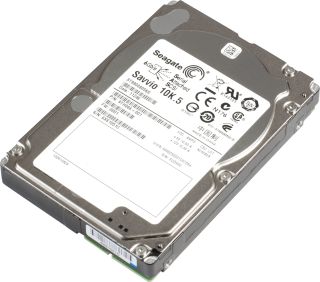Three 2.5" SAS Drives: Enterprise Data Giants, Compared
Currently, 2.5" enterprise drives are leaving their 3.5” competitors behind. They're faster, more flexible, and now they offer comparable capacities (we're up to 1 TB now). In this piece, it's Hitachi versus Seagate battling for high-density supremacy.
Seagate Savvio 10K.5 (900 GB)

Seagate's Savvio 10K.5 almost hits the terabyte mark. The 2.5” drive stores up to 900 GB of data and approaches its in-house rival, the Seagate Constellation.2, which packs on the deciding 100 GB.
Judging by the time between new drive launches in the enterprise segment, Seagate really hustled to release this model. The manufacturer only updated the Savvio series four times in the past six years. But this model's predecessor, the Savvio 10K.4, only appeared in the middle of last year. Despite the short period between the two releases, much changed. Compared to the preceding 600 GB Savvio 10K.4, Seagate adds 50% to the device's capacity and quadruples the cache from 16 MB to 64 MB. Spindle speed remains constant at 10 000 RPM.
We tested the 900 GB version of the Savvio 10K.5, which distributes data across three platters. The 600 GB and 450 GB version only use two platters and the 300 GB version uses only a single magnetic disk. For each of the four capacities, Seagate offers three models: two with SAS 6Gb/s, one with a self-encryption option, and another with Fibre Channel support (4 Gb/s). Seagate didn't provide prices at the time of testing, but we found that the 900 GB drive is available for less than $600.
In terms of performance and reliability, Seagate sets the bar pretty high. The Savvio 10K.5 should send data through the interface more than 18% faster than its predecessor, according to Seagate, and with an annualized failure rate (AFR) of only 0.44% and an MTBF of 2 million hours, it should also be ideal for inclusion in corporate systems. Both values are indeed higher than usual in the enterprise segment, but neither is extraordinary. The Hitachi Ultrastar C10K600 advertises the same values.
Our testing shows that the Seagate Savvio 10K.5 is very fast for a 2.5” drive. With an average sequential read rate of 130 MB/s and a top throughput of around 170 MB/s, the Savvio 10K.5 surpasses its predecessor by more than the promised 18%. Moreover, it remains at a cool 57°C maximum surface temperature.


Stay on the Cutting Edge
Join the experts who read Tom's Hardware for the inside track on enthusiast PC tech news — and have for over 25 years. We'll send breaking news and in-depth reviews of CPUs, GPUs, AI, maker hardware and more straight to your inbox.
Current page: Seagate Savvio 10K.5 (900 GB)
Prev Page Seagate Constellation.2 (1000 GB) Next Page Comparison Table, Test Configuration, And Transfer Diagrams-
compton Toms with some more review niceness. Thanks for another interesting article. I don't think mechanical storage is going anywhere soon. For better and worse we'll still have it around for a long, long time to come. Even when SSDs hit that magical speed/capacity/cost point to be ubiquitous for mainstream consumers, enterprises will still need HDDs as part of their storage needs. HDDs are at least a known quantity that are still getting better.Reply -
bit_user 3rd paragraph: "have to be taken into considered". You also didn't mention capacity and cost/GB, where mechanical disks still reign supreme.Reply
Also, why not benchmark a 3.5" disk, but only use the outer portion. If both that and a 2.5" have the same density and rotational velocity, then the 3.5" should win due to higher I/O speeds resulting from higher linear velocity.